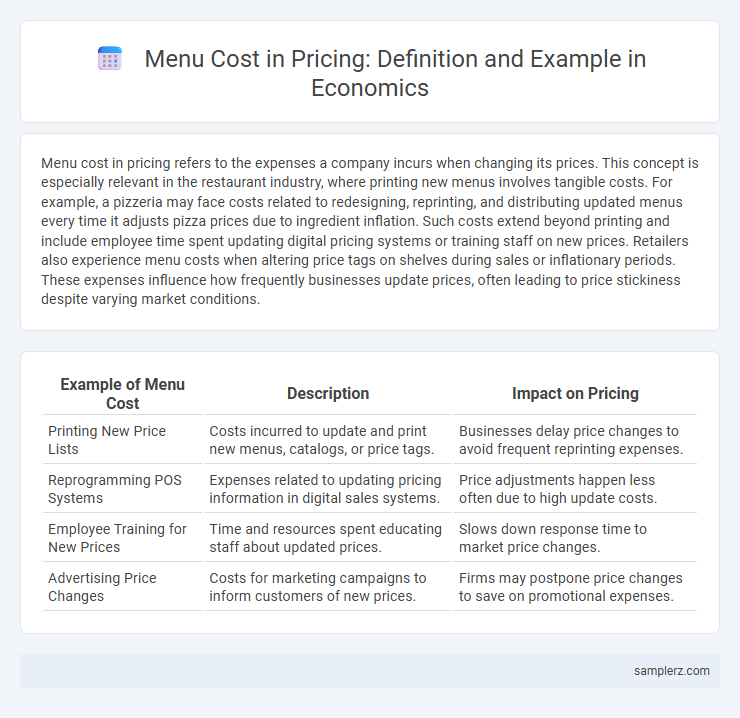Menu cost in pricing refers to the expenses a company incurs when changing its prices. This concept is especially relevant in the restaurant industry, where printing new menus involves tangible costs. For example, a pizzeria may face costs related to redesigning, reprinting, and distributing updated menus every time it adjusts pizza prices due to ingredient inflation. Such costs extend beyond printing and include employee time spent updating digital pricing systems or training staff on new prices. Retailers also experience menu costs when altering price tags on shelves during sales or inflationary periods. These expenses influence how frequently businesses update prices, often leading to price stickiness despite varying market conditions.
Table of Comparison
| Example of Menu Cost | Description | Impact on Pricing |
|---|---|---|
| Printing New Price Lists | Costs incurred to update and print new menus, catalogs, or price tags. | Businesses delay price changes to avoid frequent reprinting expenses. |
| Reprogramming POS Systems | Expenses related to updating pricing information in digital sales systems. | Price adjustments happen less often due to high update costs. |
| Employee Training for New Prices | Time and resources spent educating staff about updated prices. | Slows down response time to market price changes. |
| Advertising Price Changes | Costs for marketing campaigns to inform customers of new prices. | Firms may postpone price changes to save on promotional expenses. |
Understanding Menu Costs in Economic Theory
Menu costs refer to the expenses businesses incur when changing prices, such as printing new menus, updating advertising materials, or reprogramming electronic price displays. These costs cause firms to adjust prices infrequently despite changes in demand or costs, contributing to price stickiness in the economy. Understanding menu costs helps explain why inflation or economic shocks do not always lead to immediate price adjustments in markets.
Real-World Examples of Menu Costs
Menu costs in pricing manifest clearly in the restaurant industry, where businesses must reprint physical menus whenever they adjust prices to account for inflation or supply changes. Retailers also experience menu costs when updating price tags across thousands of products after shifts in wholesale costs or currency fluctuations. E-commerce platforms face digital menu costs due to the need for technical updates and system modifications each time they revise their pricing structures.
How Restaurants Face Menu Costs When Updating Prices
Restaurants face menu costs when updating prices through expenses such as printing new menus, retraining staff, and adjusting POS systems. Frequent price changes increase operational burdens and can reduce profit margins due to higher labor and material costs. Managing these costs effectively requires balancing price adjustments with customer perception and competitive positioning.
Menu Costs Beyond Food: Retail Price Tag Changes
Menu costs extend beyond restaurant pricing to retail sectors where changing price tags incurs significant expenses, including labor, printing, and software updates. Frequent adjustments in retail prices, driven by inflation or market fluctuations, amplify these costs and impact profitability. These hidden menu costs influence retailers' pricing strategies, often leading to less frequent price changes despite market volatility.
Digital Pricing: Are Menu Costs Still Relevant?
Menu costs remain relevant in digital pricing as businesses face expenses related to updating software algorithms, managing real-time data integration, and retraining staff for new pricing strategies. E-commerce platforms incur costs when modifying dynamic pricing systems, including server updates and potential disruptions in customer experience. These digital menu costs can influence companies' decisions on how frequently to adjust prices despite advanced automation capabilities.
Menu Costs and Their Impact on Inflation
Menu costs refer to the expenses businesses incur when changing prices, such as printing new menus, updating labels, or modifying advertising. These costs discourage frequent price adjustments, leading firms to maintain prices longer despite changing economic conditions, which can create price stickiness. Price rigidity caused by menu costs can slow inflation adjustments, contributing to persistent inflation or delayed responses to economic shocks.
Case Study: Supermarkets Adjusting Shelf Prices
Supermarkets experience menu costs when adjusting shelf prices due to the labor, time, and materials required to update thousands of price tags during inflationary periods. Studies show that these retailers delay frequent price changes to minimize expenses, which can lead to temporary mismatches between shelf prices and actual market prices. This behavior illustrates how menu costs influence pricing strategies and inventory management in competitive retail environments.
Menu Costs in the Airline Industry Pricing Strategies
Menu costs in the airline industry are exemplified by the expenses involved in updating ticket prices across various platforms, including websites, travel agencies, and booking systems. Frequent price adjustments require significant IT resources and marketing efforts to communicate changes, leading airlines to minimize price fluctuations despite market demand shifts. This rigidity results in less responsive pricing strategies, affecting revenue optimization in a highly competitive environment.
Technology Solutions to Minimize Menu Costs
Technology solutions such as dynamic pricing algorithms and automated menu update systems significantly reduce menu costs by enabling real-time price adjustments without incurring physical reprinting expenses. Cloud-based platforms and point-of-sale (POS) integration streamline the process, allowing businesses to respond swiftly to market fluctuations and optimize profit margins. These technological advancements minimize the traditional friction associated with frequent price changes in the restaurant and retail industries.
Policy Implications of Menu Costs in Modern Economies
Menu costs refer to the expenses businesses incur when changing prices, such as printing new menus or updating digital systems, which can slow price adjustments and reduce market efficiency. In modern economies, high menu costs may discourage firms from responding promptly to inflation or currency fluctuations, influencing monetary policy effectiveness and wage-setting behavior. Policymakers need to consider these costs when designing interventions, as rigid prices can lead to suboptimal resource allocation and prolonged economic imbalances.

example of menu cost in pricing Infographic
 samplerz.com
samplerz.com